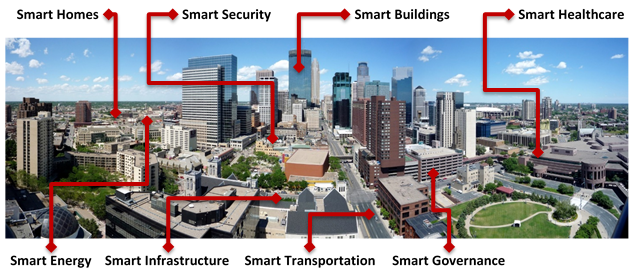|
Smart cities has been a topic of great interest of late. The infrastructure and planning situation in most cities and urban areas has not been encouraging. There has been increasing pressure on cities to work within existing infrastructure, the challenge to cut costs, and the need to utilize energy sources effectively and manage resources optimally. As migration to cities continues, the challenging environment continues to intensify. However, significant steps have been taken by companies and political/decision making authorities to create “smart cities” that are connected, responsive, scalable and productive. In addition, the increasing role and awareness of M2M/IoT solutions has influenced the decision makers, government bodies, and public authorities to invest in smart cities. All of the major technology companies such as IBM, Cisco, Oracle, Siemens, GE, Honeywell, Verizon, AT&T, etc. and political movers and shakers have increased their focus on enabling smart cities. So what defines or constitutes a smart city? Smart cities refers to cities utilizing concepts of the internet of things (IoT) and other intelligent technologies. The components of a smart city are depicted in the chart below. Compass Intelligence recently published a study on analyzing opportunities and growth prospects in the smart cities segment. Some findings are discussed below:
As noted, the smart city concept is no longer just a concept. It is very much a reality. There are so many success stories including Santander, Barcelona, Beijing, Boston, Dallas, and Singapore to name just a few. The key driving factor is the need to address increasing congestion, strain on insufficient infrastructure, and resource management challenges such as water and energy, traffic, pollution, and overall governance issues. What has helped push the concept of smart cities is the rapid level of innovation. The smart cities market is no longer plagued with the constant “what if” scenarios. Ecosystem partners along with decision makers and influencers have helped make significant strides when it comes to developing tangible use cases and deployments. At every level of participation, ecosystem partners have focused resources on creating smart technologies that enable the formation of “smart cities”. These include intelligent and advanced sensor technology, smart devices such as smart metering, switches, advanced wireless communication technologies and protocols, open platforms for more applications, cloud computing, Big Data analytics, and more. As with other IoT segments, continuing advances in technology and the IoT market will further push towards the formation of smart cities globally. What is more promising is the level of focus from companies across the ecosystem to elevate smart city offerings and fostering of synergetic partnerships. Smart cities is more than just a buzzword today. New partnerships within the value chain and innovative solutions are making smart cities a reality- be it through sensor networks, increasing automation and intelligence in hardware, software as a service model, increasing algorithms or remote monitoring and decision making control. These partnerships are taking the smart cities concept to the next step. All solutions are aimed at increasing efficiency and connectivity. The level of integration and connectivity needed to produce the desired smart cities implementation outcome is only possible through strong ecosystem integration. Strong partnerships will play a significant role in determining the future roadmap of smart cities. This is also a well-received way to monetize smart city investments quickly. As always there are two sides to any story. Smart cities growth is not without its hurdles. High cost of investment and bureaucracy are amongst the main challenges impacting smart city implementations. Integrating disparate functions and components of a city is a huge investment. In addition, decision making authorities need to overcome the bureaucracy tangle and jump through hoops to obtain permission and grants for any implementation. This has prevented cities and government bodies from making the initial high investments. However with tangible use cases and ROI case studies, ecosystem partners are helping create awareness of the long-term benefits of smart city implementations. Another factor to contend with is the long decision making time. There are too many stakeholders within the smart cities market. This includes the government (national, state and local), financiers (banks, venture capitalists, etc.), developers and builders, ecosystem partners, and citizens. Integration is another key challenge within the smart cities market. There are not just disparate segments to bring together cohesively, but one must also contend with different communication standards. For example, security systems communicate through one protocol, ZigBee etc., and smart mobility will communicate wirelessly or through some sensor network protocol. While Wi-Fi is the go-to for enabling citizen apps, overall confusion as to a cohesive solution is a challenge. There will never be a completely open or standardized protocol or standard. The smart cities market will witness companies throughout the ecosystem banding together to develop a form of standards that will spread across some applications or segments. Proprietary solutions will never completely be eradicated. These challenges are not expected to be mitigated any time soon. While the force of the drivers is expected to alleviate the impact of these challenges to a great degree, they will persist. However, as mentioned above, ecosystem partnerships will help reduce the impact of the challenges greatly. Continued focus on smart technologies and the push from ecosystem partners will continue to boost smart city deployments. There will be more focus on gathering data and gleaning valuable information regarding patterns and consumer behavior. There is a lot of education and awareness that is being proliferated across stakeholders to increase investments and shorten the long decision making cycle. Smart energy and smart governance will lead growth rates. However mobility will offer more tangible return on investment. Security at all segment levels will continue to increase. The ecosystem is still fragmented, however a few companies have certainly carved out a strong market position. Companies across the ecosystem will continue to look for avenues to expand their customer base and increase revenues. The one sure way of obtaining this goal is through offering an end-to-end solution or acting the role of facilitator/consultant. Currently, no such company exists that spans solutions across all segments and applications. There will be increasing overlap in the roles system integrators, hardware companies, telecom companies, and service providers play. All said and done, the smart cities market offers a great potential for growth globally, across all its segments and in applications and technologies.
8/2/2018 07:11:59 am
Although, I completely agree with the overall message of the article, that smart city initiatives need to be driven by analytics, I also think that by placing a real-world problems like for example, at the very center of the smart-city will make a stronger case politically and socially. Comments are closed.
|
Inside MobileCovering hot topics in the industry, new research, trends, and event coverage. Categories
All
|


 RSS Feed
RSS Feed
